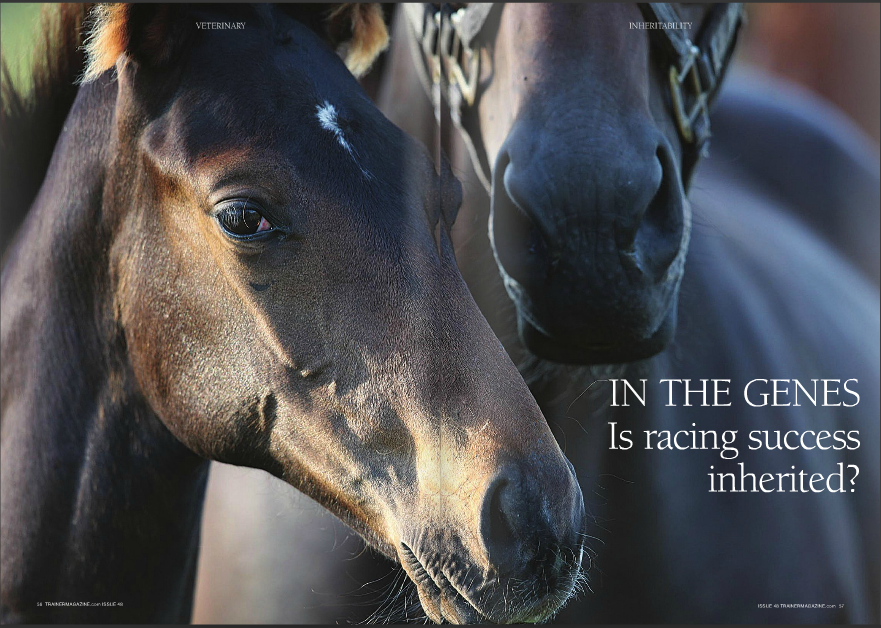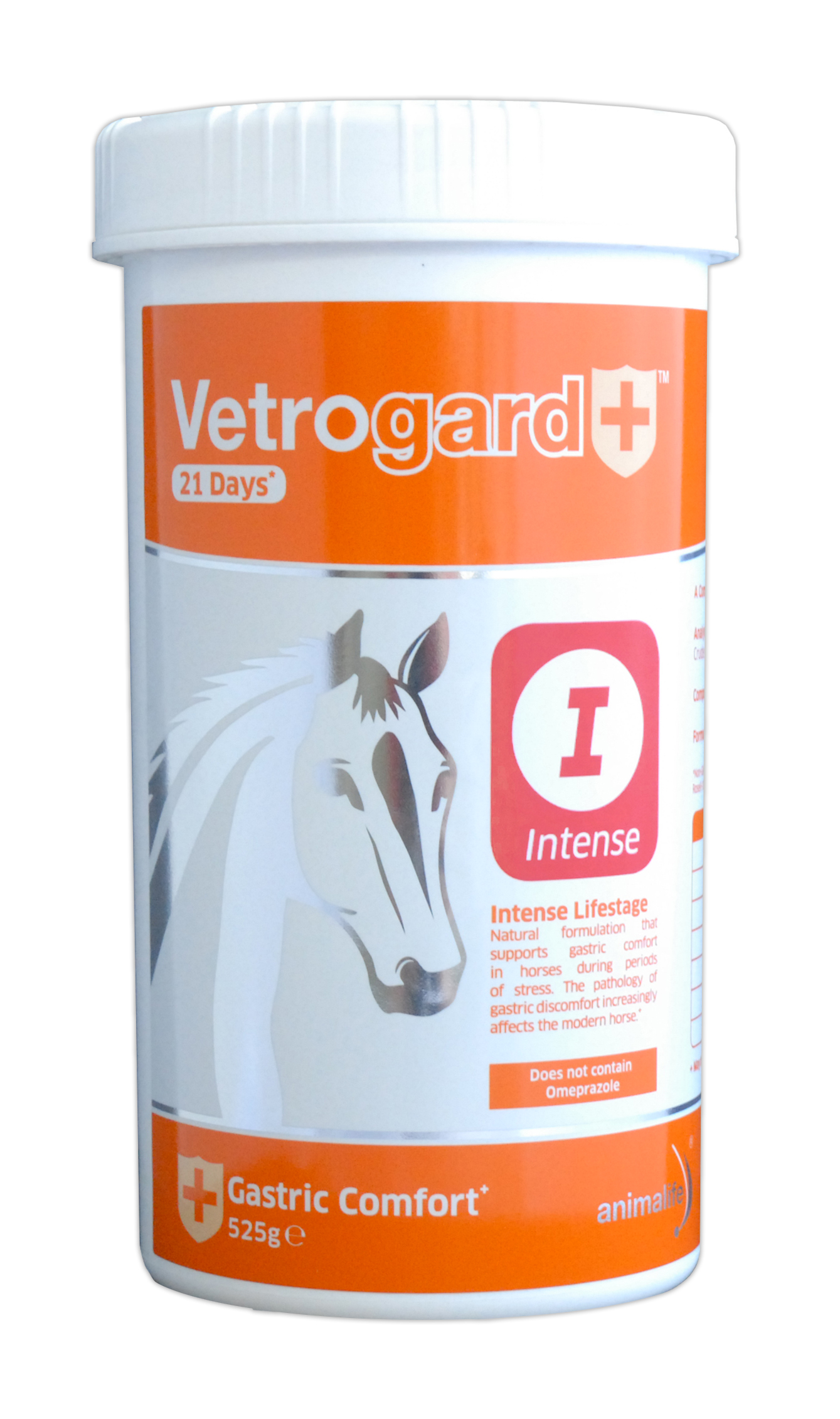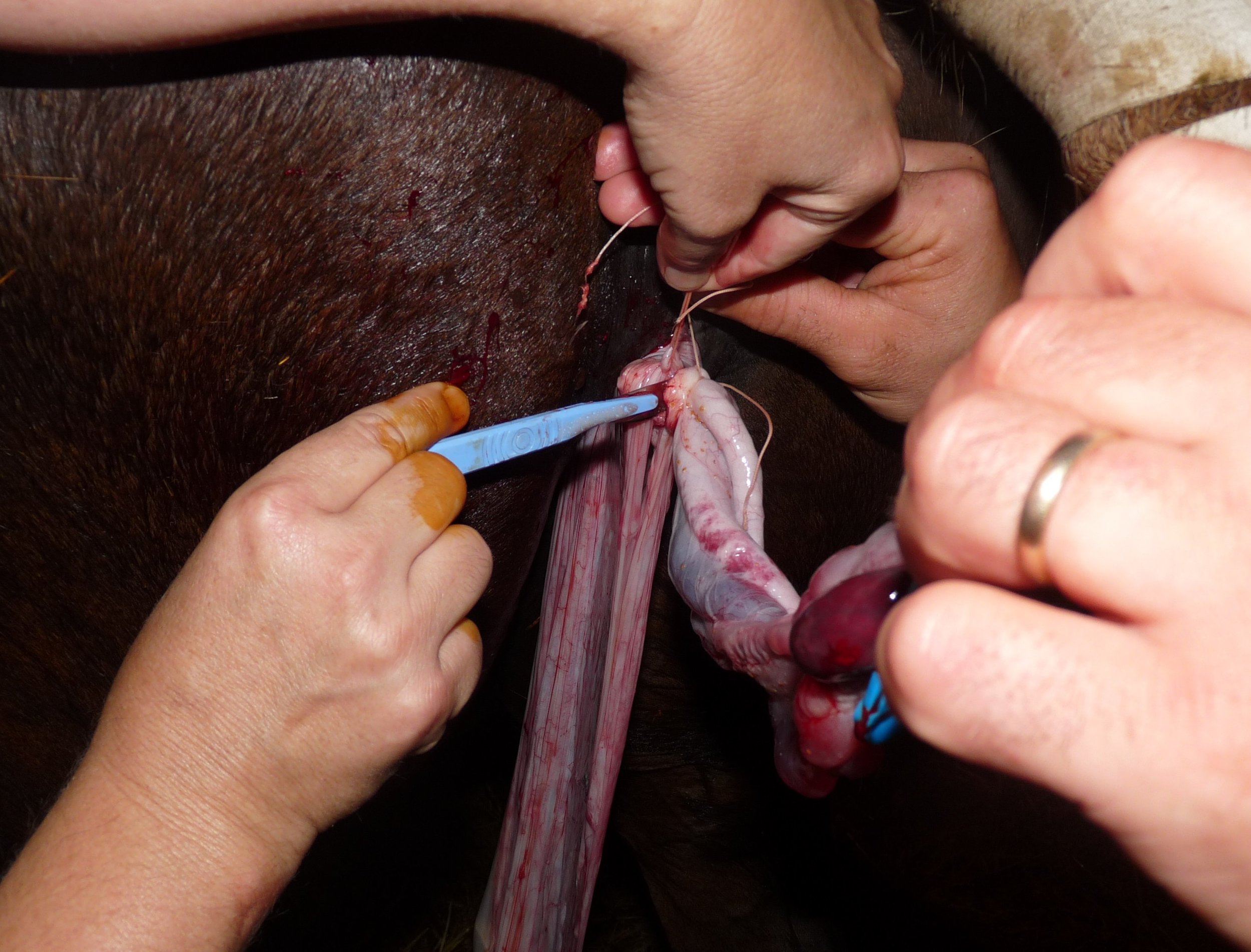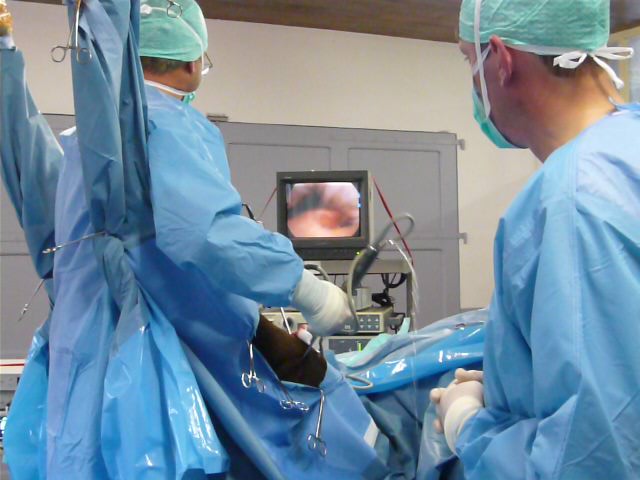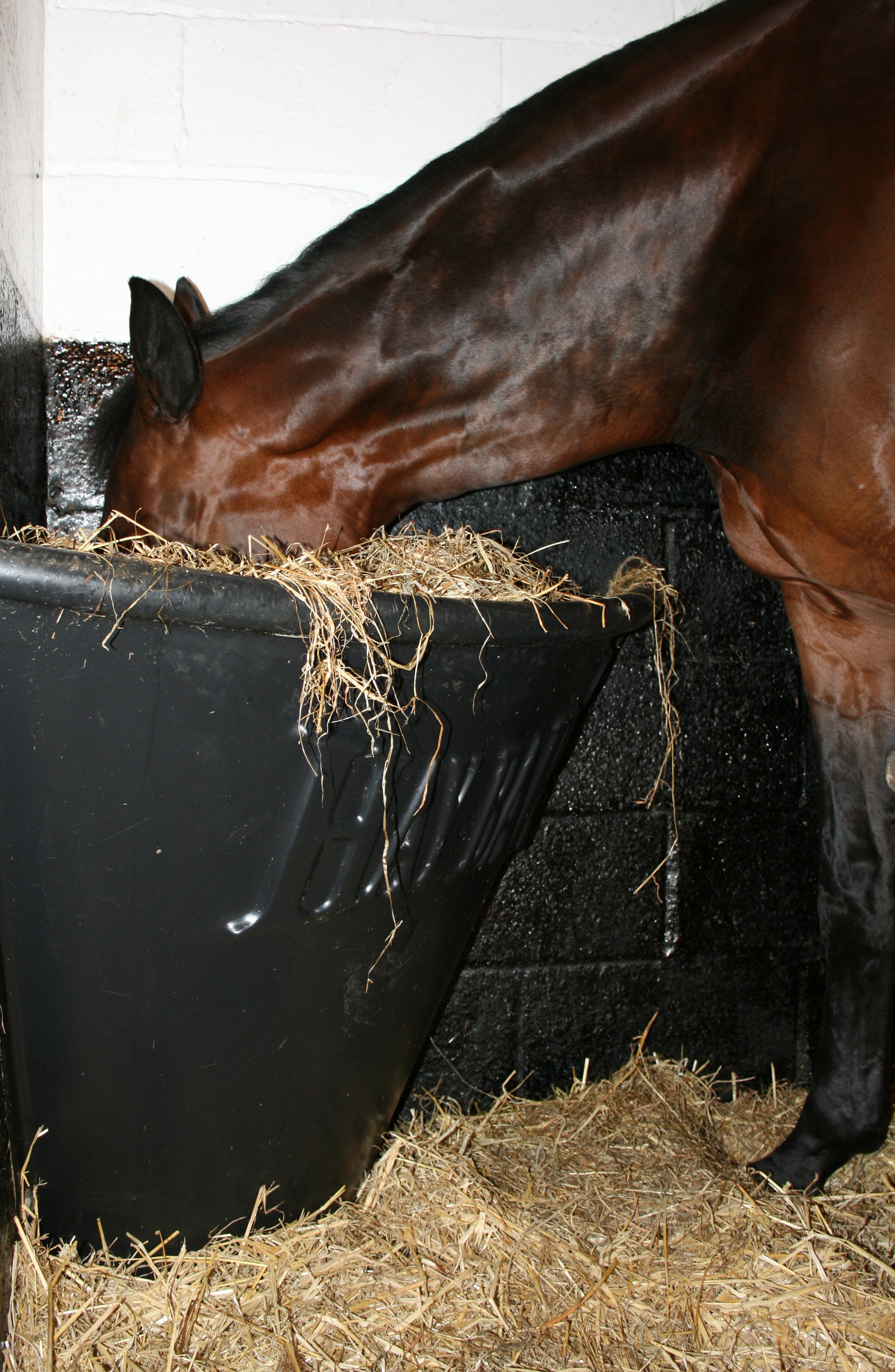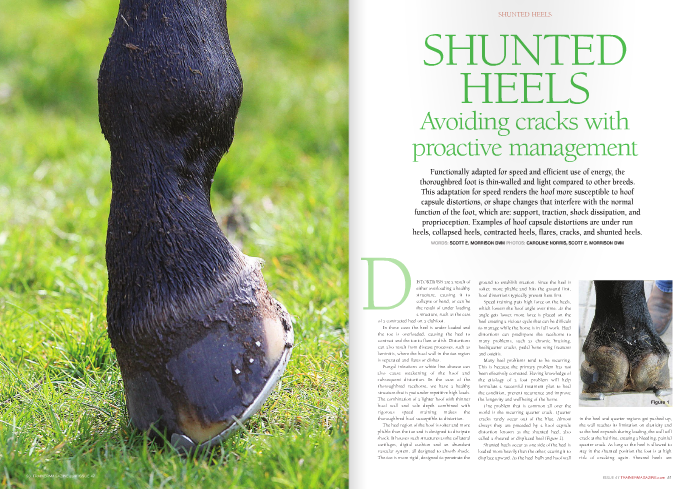Ovvet: Gastric Control Gold
Gastric ulceration is a serious yet common condition that can affect any horse, at any age. The racehorse in training is particularly susceptible; studies show that 93% of this group suffer from stomach ulcers, yet the symptoms can be unspecific often with the horse showing no outward clinical signs. As a result they are frequently not recognised, therefore remain untreated. These symptoms are very similar to colic which remains the single largest cause of death in the equine industry. However, research shows that every horse, not just racehorses, will suffer with varying degrees of ulcers at most times of its life.
The treatment of this multi-faceted disease is fast emerging as one of the greatest challenges in contemporary equine medicine. Ovvet’s aim is to educate and inspire the equine industry to use a range of functional superfood products, which have been developed to help in achieving optimal intestinal activity and overall equine health.
Equine Gastric Ulcer Syndrome (EGUS) is erosion of the stomach lining, caused by constant exposure to gastric acid and spans a wide spectrum of severity, from inflammation of the epithelium (stomach lining) to perforation and bleeding. Diagnostic classification includes a point scoring system from 0 to 4, with 2 and above considered clinically significant.
A healthy gastro intestinal tract will positively affect a variety of functions in the horse and is key to its performance and wellbeing. Ovvet’s Gastric Control Gold is a clinically tested unique formula specifically designed for horses susceptible to colic or suffering from EGUS.
Highly developed natural ingredients, including Fermaid®Ease 187 (strain 1077), organic mushroom compound, Levucell SC (a natural live yeast to assist digestion) and omega 3 provide anti-inflammatory and pain-relieving treatment, stabalising the pH value of the colon and giving genuine assistance in repairing the ulcerated tissue. Gastric Control Gold is rich in vitamin D, antioxidant and boosts the immune system.
Fermaid®Ease 187 (strain 1077) is the end product from the fermentation of high-quality soya flour with a certain lactic acid bacterium, L. delbrueckii, which stimulates macrophage and lymphocyte activity. In clinical trials at Newmarket, horses treated with Fermaid®Ease 187 (strain 1077) were found to have significant improvements in their clinical symptoms, with pain considerably reduced and in most cases, the absence of colic. Following pre-treatment with Omeprozal (for grades 3 and 4), there were considerably fewer recurring ulcers.
For more information on Gastric Control Gold and other products from Ovvet contact tel: 01604 874693 email: colin@ovvet.eu or visit www.ovvet.eu
Hooves and ground surface - the impact of intentional shoeing interventions
The interaction of a horse’s foot and the ground surface is complex. Stance—that part of the stride when the foot is in contact with the ground—can be divided into three phases, which determine the loading environment of the limb: impact, mid stance and push off. Loading of the limb determines how it functions and also influences where injury may occur. Research funded by the Horserace Betting Levy Board at the Royal Veterinary College has focussed on the foot and is allowing a greater understanding of the effect of changes in surface or shoeing on stance, on remodelling of the tissues and ultimately on the risk of injury.
Let there be light - how daylight affects performance and safety
Recipient of multiple awards, including the Saratoga Trainer’s Title and the Eclipse Award for Outstanding Trainer, Bill Mott is no stranger to travelling with his horses. For example, Mott was trainer and chaperone of Cigar, winner of the inaugural Dubai World Cup in 1996. How do Mott and other elite trainers consider the impact of jet lag, light-dark cycles, and other factors associated with shipping across times zones on their horses’ performance?
Is the handicapping system a handicap to our industry?
A sad indictment of racing is that many punters hold the belief that half the horses in a race are ‘not trying’, and we have to wonder, what gave them that impression?
Chairman's message - Criquette Head
As 2014 draws to a close, I hope that some trainers will have time to take a rest and reflect on some of the great performances of the season. I offer my congratulations to winners of all races, big and small, throughout the past year.
Do racetrack incentives lead the way to a drug-free future?
The horseracing industry is battling for its life, and the key point of contention is medication—not just a push for uniform medication rules, but a movement to eliminate all race-day drugs. Two years after the Breeders' Cup banned anti-bleeding medication for its juvenile races, Gulfstream Park in Florida has announced its intention to offer Lasix-free races for 2015, and the Kentucky Horse Racing Commission is considering doing the same for its tracks. North America is the only region of the world that allows race-day medication.
Trainer on the Up - Super Swede, Jessica Long
Jessica Long has only been training for five or six years but her pedigree (she is the daughter of Swedish trainer Caroline Stromberg) speaks volumes, with recent victory at Jägerso, with home-bred Berling victorious in the Swedish Open Mile, followed by Volatile’s terrific 3rd place in the Dubai Cornwallis Stakes at Newmarket this October. Both horses were her first British runners, Berling being entered in the Darley Stakes the same day.
TRM Trainer of the Quarter - Francisco 'Paquito' Rodriguez
At the close of the autumn season, a packed Hipodromo de la Zarzuela, watched Rodriguez trained Arkaitz triumph in a closely fought Gran Premio Villamejor; a race which saw Ziga make things very difficult for the 3 year old and almost overtake him. However, Triple Crown (Poule, Derby and Villamejor) glory belonged to Arkaitz and Rodriguez.
Support performance from within with Vetrogard
The management of a racehorse in training often means long periods in the stable and little time in the field grazing. Combined with high levels of concentrate feed, this routine can result in periods without forage, for instance if the horse finishes his or her hay or haylage well before next feeding time. In addition, intense training regimes and regular travel can lead to high stress levels. All these changes can challenge the racehorse’s digestive system.
The imbalance of a stomach expecting a supply of food 24/7, but in reality receiving discrete meals throughout the day, leads to an excess of gastric acid which can cause discomfort. This in turn can negatively affect appetite, condition, droppings and behaviour – all of which can prevent your horse from performing to their optimum.
Animalife, the creators of Vetrofen and Vetroflex, have introduced Vetrogard Intense to their range of high performance supplements. The dual action, nutritional formulation has been designed to support gastric health and comfort. Studies have shown that horses fed Vetrogard have improved appetite, condition and faecal quality scores.
Vetrogard Intense helps support the gastric epithelium and acts to assist the body’s natural defences to any gastric acid splash in stabled, exercising horses.
Vetrogard Intense is free from banned substances and 100% natural. Vetrogard Intense is available in a 525g tub, priced at £99.99.
Call +44 (0)1564 794 586 to find your local Animalife Accredited Retailer or order online at www.animalife.co.uk (subject to delivery charges).
OMBISTEM-Vet stem cell treatment from Vetbiobank
Whether it be an Olympic track gold medallist or a Derby winner, all athletes, will inevitably suffer injuries to ligaments, joints and tendons. This goes with the territory. Every trainer, be it human or equine, hopes to restore his charge quickly to full competitive glory both legally and economically.
Regenerative medicine has been in force in human clinics and the vet’s practice for over a decade using products such as platelet rich plasma (PRP) or stem cells. However, over the last few years the use and type of stem cells has changed dramatically.
Historically, stem cells were obtained from the fat or bone marrow of the horse to be treated and then injected as a crude product into the injured site immediately or after a 2-3 week delay needed to produce sufficient cells. Detrimentally, cell potential decreased with the time lag during production and treatment was done usually when fibrosis was already manifest.
Vetbiobank’s treatment options are based on having a bank of ready-to-use neonatal stem cells obtained from the umbilical cord that can be administered well before fibrotic onset.
Vetbiobank’s, OMBISTEM-Vet system offers advantages over traditional stem cells products. The cells are fitter and more standardised and less subject to the vagaries of adult cells whose therapeutic potential decreases with age. Their gestational origin means those cells are less immunogenic, thus allowing treatment of both related and unrelated horses.
Stem cells implanted in a clinically manifest lesion will also migrate to other injured sites which means they preserve health by repairing other undetected lesions. (European trainer magazine June 2014).
This development has attracted widespread interest within the racing community. Furthermore, cord collection can be performed easily in any hygienic stable. Therefore, a stud farm can build with Vetbiobank, a cell bank to treat a lifetime of common horse injuries.
For a racing stable, without its own bank, it is still possible to access cord stem cells from Vetbiobank’s OMBISTEM-Vet product to treat injuries.
Vetbiobank’s expertise in neonatal stem cell banking and research enables them to offer a BESPOKE pan European cell therapy service to vets, trainers, breeders and horse owners.
Visit www.vetbiobank.com for more information.
Hay Bar
Planning and building a new yard can be quite an undertaking. The horses welfare is paramount yet the design and construction must be efficient and cost effective. Running costs for any yard can become a serious financial liability and, with forage prices set to rise, it is essential that we try to find ways of becoming more economical and less wasteful.
Hay Bar is a proven sound investment in many ways. Stabled horses benefit from feeding from the floor, as it helps to maintain their natural way of foraging. This, in turn, helps to ensure that mentally they are more relaxed and that there are less respiratory, dental and physio problems, all of which can prove to be costly and, to say the least, inconvenient.
Other unnecessary and unwanted expenses are waste forage and bedding: Hay Bar helps to ensure that forage does not become contaminated and ensures the horse gets the full benefit of what he is being fed.
Labour costs are rising all the time, so it is important that time is well spent. Filling hay nets is time consuming. The Hay Bar system is labour saving, safer, more hygienic, better for our horses and the solution to numerous problems.
Tel: + 44 (0)1723 882434 for more information or visit www.haybar.co.uk
Cover Profile - Guillermo Arizkorreta
In eight years with a licence, Guillermo Arizkorreta has been Spain’s champion trainer three times and has his sights set on a prime international target.
Criquette Head - Chairman's message
I hope that you have all had a successful summer of racing. We have enjoyed some top-class action over the past months and I would like to congratulate the trainers of winners at all levels.
I welcome the movement of American trainers who are lobbying for the elimination of race-day medication in the USA. This subject has been discussed for many years and it is most satisfactory to see that so many leading American professionals are now lending their support to the proposal to phase out race-day medication, starting with two-year-olds from next year and for all horses from 2016.
“Drugs were in the news in Europe this summer with the positive tests for morphine in the UK”
On behalf of the ETF, I pledge our support for drug-free racing in America. It would be a great step forward for horse welfare and, above all, for the wellbeing of the American breeding industry as a whole if these new regulations could finally be adopted.
Drugs were in the news in Europe this summer with the positive tests for morphine in the UK. I was pleased to note the reaction of the British authorities, who recognised that the trainers concerned were implicated through no fault of their own and that, accordingly, they received no sanctions.
THERE'S MORE TO READ ONLINE....
THIS ARTICLE FIRST APPEARED IN EUROPEAN TRAINER - ISSUE 47
TO READ THIS ARTICLE IN FULL - CLICK HERE
Shunted heels - Avoiding cracks with proactive management
Functionally adapted for speed and efficient use of energy, the thoroughbred foot is thin-walled and light compared to other breeds. This adaptation for speed renders the hoof more susceptible to hoof capsule distortions, or shape changes that interfere with the normal function of the foot, which are: support, traction, shock dissipation, and proprioception.
Streptococcus zooepidemicus - The bug that can place bets
The Horserace Betting Levy Board (HBLB) has invested over £7 million to protect racing and ensure horse welfare by disease surveillance and research on prevention of equine infections over the last decade. Infection with bacteria is one of the important causes. One bug in particular that can be found in many cases is Streptococcus zooepidemicus.
Respiratory disease affects a large proportion of young horses around the world, reducing performance with significant disruption to training and racing schedules. Inflammatory airway disease affects young horses in particular and it generally causes mucus in the trachea. Some estimates suggest that in British Flat racing yards, for every 100 horses, each month there will be nine cases.
Coughing and nasal discharge can last around eight weeks and some animals are affected again and again. All of which leads to significant cost to the racing industry. As a result, this problem has been a long-standing focus of attention for the Horserace Betting Levy Board’s (HBLB) veterinary research efforts.
Bacterial genetic code
One reason why bacteria from the same species might affect horses differently is that there are different strains within a bacterial species. This is rather like different breeds of horses – a Falabella pony is the same species as a thoroughbred – but it looks and acts very differently. All living things, from human to single-cell algae in the ocean, have a genetic code written in DNA. Understanding this genetic code can reveal how organisms live and function.
“In the same way as Strangles, a horse that has recovered from Streptococcus zooepidemicatus might no longer be outwardly affected itself but it may still carry the bug”
An HBLB-funded collaborative team working in Dr Andrew Waller’s lab at the Animal Health Trust and Professor Josh Slater’s lab at the Royal Veterinary College have set out to unlock the genetic make-up of different strains of Streptococcus zooepidemicus in order to understand better if some strains of this bacteria cause disease while others are relatively harmless. The researchers also looked at how different strains of Streptococcus interact with the horses’ immune system. The ulitmate goal of this research is to gain the knowledge which will lead to new vaccines.
A global research effort
The researchers started by developing a technique to produce a unique ‘genetic fingerprint’ with which to identify each different strain of the Streptococcus. They then tested samples from sick horses around the world and so far 318 different types of S. zooepidemicus have been identified with two particular strains being responsible for outbreaks of respiratory disease.
Insight from an ancient threat: Strangles
The researchers had some clues about what they might find in the samples from horses with Streptococcus zooepidemicus infection because they already had extensive experience in similar research in Strangles. Strangles is one of the oldest known, feared and most frequently reported infectious diseases of horses throughout the world. Typical signs of Strangles include abscessation of the lymph nodes in the head and neck, with swelling to such an extent that some horses are literally suffocated. It is caused by a relative of Streptococcus zooepidemicus, known as Streptotococcus equi. With Strangles, it is very clear that some recovered horses become carriers. Carriers show no outward signs and this hidden infection enables the bacteria to be spread around undetected.
S. zooepidemicus colonies grown on a blood agar culture plate
Silent carriers lead to infection in youngsters
In the same way as Strangles, a horse that has recovered from Streptococcus zooepidemicatus might no longer be outwardly affected itself but it may still carry the bug. For example, the particular strain responsible for the outbreak of respiratory disease in Sweden was found in a healthy horse eight months after the horse made a full clinical recovery.
This persistence of S. zooepidemicus in thoroughbred racehorses that have recovered from respiratory disease allows transmission to susceptible animals and can occur when, for example, older recovered horses are mixed with the next year’s intake of young horses. It is likely that immunity to one strain of Streptococcus does not fully protect a horse from all the other strains, so young horses can often succumb to a succession of respiratory infections as they gradually build up immunity to mix of Streptococcus zooepidemicus strains that persist in that particular yard.
Bacterial balancing acts
In order to be able persist in recovered horses Streptococcus zooepidemicus must be able to survive despite the fact it is being attacked by the horse’s immune response, and at the same time, the bug must be ready to infect a susceptible animal should the opportunity arise. S. zooepidemicus strains have proteins on their surface and some of these proteins inactivate the horse’s immune response. Other proteins enable the bacteria to stick to the internal surfaces of the horse in order to establish the infection, almost like an ice climber clinging to the surface of a glacier with the crampons on his boots. If he loses his crampons, he is in big trouble.
Thus, these surface proteins play key roles for the bacteria, but they are also a vunerable point and can be targeted by the horse’s immune response to disable the bacteria. Therefore, balancing the array of surface proteins displayed with the particular requirements of the bacteria at any given time is critical if the bacteria are to successfully establish an infection and transmit to a new susceptible animal.
THERE'S MORE TO READ ONLINE....
THIS ARTICLE FIRST APPEARED IN EUROPEAN TRAINER - ISSUE 47
TO READ THIS ARTICLE IN FULL - CLICK HERE
Author: Celia Marr, Andrew S. Waller & Josh Slater
Tongue-ties - their place in racing in 2014
Tongue-ties (strips of material passed through the horse's mouth over the tongue and tied under the jaw) have been used for generations on racehorses worldwide as a method for the rider to retain control if his horse is prone to manoeuvering it's tongue over the bit. The use and efficacy of tongue-ties has spawned much debate and the Equine Veterinary Journal published reports in 2009 and 2013 evaluating use on racing performance and airway stability in thoroughbred racehorses.
Cardiac rhythm - new technology brings new insights
When a horse runs badly, after lameness and respiratory disease have been ruled out, the heart is usually the next suspect. A new study, published in the Equine Veterinary Journal, provides significant insights into cardiac rhythm abnormalities that can develop during and after racing in standardbreds.


